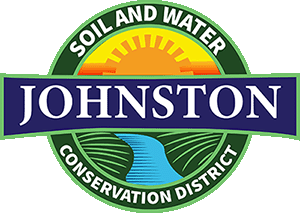
Soil and Water Conservation
Johnston County, North Carolina

Johnston County, North Carolina
Coastal wetlands provide a wide variety of important functions, including:
Water quality. Some wetlands contribute to improving water quality by removing excess nutrients and many chemical contaminants.
Barriers to waves and erosions. Coastal wetlands reduce the impact of storm tides and waves before they reach upland areas.
Flood storage. Coastal wetlands can store floodwater and release it slowly, lowering flood peaks.
Sediment control. Reduced flood flow provided by coastal wetlands allows floodwater to deposit sediment.
Wildlife habitat. Coastal wetlands can support wide varieties of wildlife.
Fish and shellfish. Coastal wetlands are important spawning and nursery areas for fish and shellfish, and provide good sources for commercial fishing.
Sanctuary for rare and endangered species. Protection of wetlands often means providing good habitats for endangered animals. An estimated 43 percent of the threatened and endangered species in the U.S. rely directly or indirectly on wetlands for their survival.
Aesthetic value. The natural beauty of wetlands is a source of visual enjoyment.
Education and research. The rich ecosystems of wetlands are natural locations for biological research and observation.
Recreation. Wetlands provide sites for hunting, fishing, and observing wildlife.
Food production. Wetlands have potential for the production of plant products, including marsh vegetation, and for aquaculture. Wetlands also produce great volumes of food in the form of decaying plant and animal matter or detritus. Detritus is consumed by many aquatic invertebrates and fish which are food for game fish, waterfowl, and mammals.
Water supply. With the growth of urban areas, wetlands are becoming more valuable as sources for water supply.
Coastal salt water wetlands contain a number of habitats. Marine inter-tidal habitats are near the shoreline and are flooded by tidewaters. Estuarine sub-tidal habitats are open water and bay bottoms that are continuously covered by salt water. Estuarine inter-tidal emergents are salt marsh areas that are covered by vegetation during the growing season. Estuarine inter-tidal forested/shrub habitats contain larger woody plants. Estuarine inter-tidal unconsolidated shores are beaches and sand bars, and estuarine unconsolidated bottom habitats are open water estuaries. Riverine habitats are tidal or non-tidal river systems that feed into wetlands.
Estuaries form where rivers meet oceans. Estuaries are deep water tidal habitats and adjacent tidal wetlands that are usually semi-enclosed by land but have open or at least some access to the open ocean. Ocean water in estuaries is partly diluted by freshwater runoff from rivers, but the salinity of still waters in estuary wetlands may be occasionally higher than that of the ocean due to evaporation.
Bays are large estuarine systems. The Chesapeake Bay is the largest estuary in the United States and one of the most productive biological systems in the world. The bay is approximately 200 miles long and ranges from 4 to 30 miles wide, but averages a depth of only about 28 feet. This makes it ideal for shellfish and other productive fish species, but also makes it sensitive to natural changes in temperature and wind and man-made pollution. Other key bays in the United States include Puget Sound in Washington, Long Island Sound in New York, Albemarle/Pamlico Sounds in North Carolina, and San Francisco Bay in California.
Coastal wetlands are critical to human food supplies. About 66 percent of the commercial fish catch taken along the Atlantic and Gulf coasts depends on wetlands for survival. Coastal wetlands produce millions of tons of organic matter that provide food for invertebrates, shellfish, and small fish that are in turn food for larger commercial fish such as bluefish and striped bass. Most freshwater fish feed upon wetland produced food and use wetlands as nurseries for their young. Waterfowl hunters spend over $300 million annually to harvest wetland-dependent birds. Wetlands provide blueberries, cranberries, and wild rice. And wetlands have further potential for contributing to the food supply, through the harvesting of marsh vegetation and aquaculture.